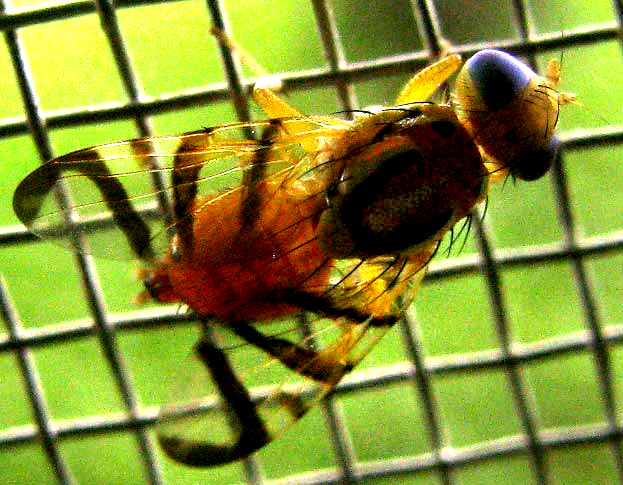Excerpts from Jim Conrad's
Naturalist Newsletter

from the June 15, 2014 Newsletter issued from the Frio Canyon Nature Education Center in the valley of the Dry Frio River in northern Uvalde County, southwestern Texas, on the southern border of the Edwards Plateau; elevation ~1750m (~5750 ft); N29.62°, W99.86°; USA
A FRUIT FLY MIMICKING A JUMPING SPIDER
At the house in the valley where I was painting, a fruit fly was hanging on a veranda's wire screen. I knew it was a fruit fly because it was small with a yellowish body, blue eyes, dark markings on its otherwise transparent wings, and every few seconds it would curl and flex its wings in a strange way I've only seen fruit flies do, a behavior known as wing-waving. That him above.
Actually, the term "fruit fly" is so general and imprecise that it doesn't say much about who the fly actually is. Not only many genera but also several entire fly families are known as fruit flies. The best known fruit flies are of the genus Drosophila, but they're much smaller than the one in our picture, Using the dandy BugGuide.Net website and the picture-matching technique described here awhile back, our little fly was so distinctive that I could figure out its genus, Zonosemata. And since the genus Zonosemata embraces species that can damage agricultural crops, there's a fine illustrated key to Zonosemata species, free to download in PDF format, at the researchGate.Net website, The Genus Zonosemata, With Notes on the Cytology of Two Species (Diptera— Tephritidae), by Guy Bush at Michigan State University.
It's ZONOSEMATA VITTIGERA, with no good common name, though often it's referred to as a tephritid fly, a general name alluding to its membership in the family Tephritidae, one of the two largest families holding species most commonly referred to as fruit flies. Because of their bright colors and bold wing markings, members of the Tephritidae are sometimes called peacock flies.
Zonosemata vittigera is a bit famous, and its wing-waving is part of what it's famous for. That's because the dark lines on its wings, the markings atop its thorax, and its wing-waving all contribute to enabling the species to mimic the territorial display of its jumping spider predators. In other words, jumping spiders prey on fairly defenseless Zonosemata fruit flies, but when the flies wave their wings, to a jumping spider it looks like another jumping spider making threatening displays at them, so the spider retreats.
To see the spider in our fruit fly, look at our picture thinking in terms of the fly's roundish, yellow rear end, or abdomen, as a spider's front body segment, or cephalothorax, and the fly's dark thorax (segment behind head) as the spider's abdomen, with the dark bars on the fly's wings being legs issuing from the spider's cephalothorax. When the fruit fly wing-waves, to the jumping spider it looks as if the enemy spider is signaling its "agonistic territorial display" with its legs a display that can be interpreted into plain English as "This is my territory, so get away!"
Amazingly, it's been proved that the mimicry practiced by Zonosemata flies actually does keep jumping spiders from attacking them. The experiment consisted of transplanting housefly wings onto Zonosemata vittigera, and Zonosemata vittigera wings onto houseflies. Both Zonosemata flies with transplanted house fly wings and house flies with transplanted Zonosemata wings were attacked by jumping spiders, which shows that both the fruit fly's wings and body markings are important in order to deceive the spider.
Zonosemata vittigera mostly occurs in Mexico, from the Isthmus of Tehuantepec northward, extending into the US from Arizona to Oklahoma and Texas.
The only known host plant for Zonosemata vittigera is the Silver-leaf Nightshade, Solanum elaeagnifolium, an abundant roadside weed here. We profile it at http://www.backyardnature.net/n/h/solanum1.htm.